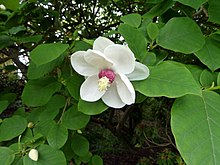Magnolia sieboldii
| Siebold's Magnolia | |
|---|---|
 |
|
| Scientific classification | |
| Kingdom: | Plantae |
| (unranked): | Angiosperms |
| (unranked): | Magnoliids |
| Order: | Magnoliales |
| Family: | Magnoliaceae |
| Genus: | Magnolia |
| Subgenus: | M. subg. Magnolia |
| Section: | M. sect. Rhytidospermum |
| Subsection: | M. subsect. Oyama |
| Species: | M. sieboldii |
| Binomial name | |
|
Magnolia sieboldii K.Koch |
|
| Synonyms | |
|
|
Magnolia sieboldii, Siebold's Magnolia, also known as Korean mountain magnolia and Oyama magnolia, is a species of Magnolia native to east Asia in China, Japan, and Korea. It is named after the German doctor Philipp Franz von Siebold (1796–1866).
Magnolia sieboldii is a large shrub or small tree 5–10 m tall (16-32 feet). The stalks, young leaves, young twigs and young buds are downy. The leaves are elliptical to ovate-oblong, 9-16 cm (rarely 25 cm) long and 4-10 cm (rarely 12 cm) broad, with a 1.5-4.5 cm petiole.
The flowers, unlike the better-known spring flowering Magnolias, open primarily in the early summer, but continue intermittently until late summer. They are pendulous, cup-shaped, 7-10 cm diameter, and have 6-12 tepals, the outer three smaller, the rest larger, and pure white; the carpels are greenish and the stamens reddish-purple or greenish-white.
There are three subspecies:
Magnolia sieboldii is grown as an ornamental tree in gardens. It is one of the hardiest magnolias, successful in cultivation as far north as the Arboretum Mustila in Finland. The cultivar 'Colossus' has gained the Royal Horticultural Society's Award of Garden Merit.
Called mongnan or mokran (목란/木蘭), Siebold's magnolia is the national flower of North Korea.
...
Wikipedia
